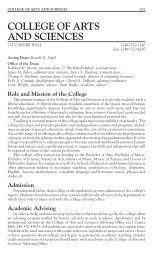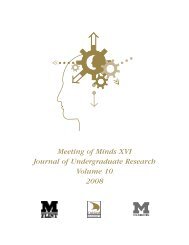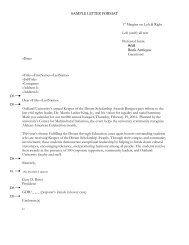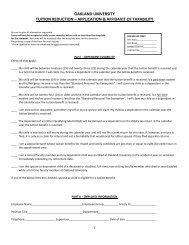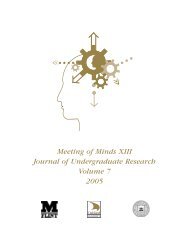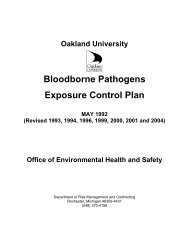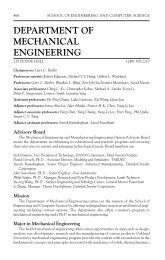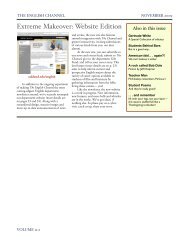MOM 2006 journal for pdf.pmd - University of Michigan-Flint
MOM 2006 journal for pdf.pmd - University of Michigan-Flint
MOM 2006 journal for pdf.pmd - University of Michigan-Flint
Create successful ePaper yourself
Turn your PDF publications into a flip-book with our unique Google optimized e-Paper software.
A<br />
B<br />
C<br />
D<br />
Figure 3 Sections <strong>of</strong> end-<strong>of</strong>-tail tissue with structures showing unorganized growth that is atypical in a<br />
normal regenerating tail. A: (Exp #9) Muscle, epithelium, notochord, and a flattened nerve tube are<br />
apparent. B: (Exp #11) visible structures include mesenchyme, pigment, epithelium, and possible<br />
notochord. C: (Exp #12) Neural tube, notochord, pigment, epithelium, mesenchyme cells, skeletal<br />
muscle, and nuclei. D: (Exp #12) this section includes lots <strong>of</strong> muscle, a good indication <strong>of</strong> possible limb<br />
induction. Also shows visible neurons, mesenchyme, and epithelium.<br />
DICUSSION<br />
Maden has stated that tadpoles from the species Rana pipiens do not show homeotic<br />
trans<strong>for</strong>mation after tail amputation. We have shown that by using the retinoids all trans retinyl<br />
palmitate and cis and trans retinyl palmitate, most Rana pipiens tadpoles regenerated abnormal<br />
tails and showed possible limb induction. These two <strong>for</strong>ms <strong>of</strong> retinoids resulted in similar effects<br />
on regeneration and limb induction in Rana pipiens. Both treatments resulted in tail<br />
abnormalities and possible limb <strong>for</strong>mation. Maden (1996) used three different retinoids (retinyl<br />
palmitate, all-trans-retinoic acid, and TTNPB) in which he concluded TTNPB to give the highest<br />
result <strong>of</strong> limb induction as it is a more potent <strong>for</strong>m. This could be one reason as to why our<br />
experimentations did not yield high rates <strong>of</strong> limb <strong>for</strong>mations.<br />
We have shown that retinoids have the potential to alter normal development and regeneration<br />
in Rana pipiens, but only at certain duration <strong>of</strong> treatment, concentrations, and metamorphic<br />
stages. Maden (1993) reported that, ideally, 2-3 days is best; shorter or longer amounts <strong>of</strong> time<br />
resulted in less observed tail regeneration, and high fatality rates, respectively. Treating with 10<br />
Meeting <strong>of</strong> Minds <strong>2006</strong> 146



